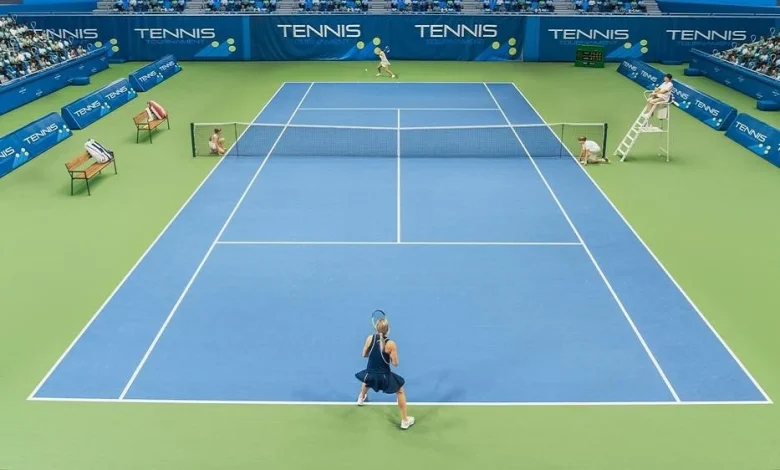Exploring the World of Tennis Courts: A Comprehensive Guide

Tennis, often referred to as the sport of kings, is a beloved pastime enjoyed by millions of players and fans worldwide. Central to the game of tennis are the courts, the battlegrounds where players showcase their skills, agility, and strategy in exhilarating matches filled with power, finesse, and precision. Tennis courts come in a variety of surfaces, sizes, and configurations, each offering its unique playing characteristics and challenges. In this comprehensive guide, we will explore the world of tennis courts, delving into their history, construction, surfaces, maintenance, and significance in the sport of tennis.
Evolution of Tennis Courts
The origins of tennis can be traced back to 12th-century France, where it was played as a game called “jeu de paume,” or “game of the palm.” Initially played indoors on a hard surface, the game eventually transitioned to outdoor courts, which allowed for more expansive play and strategic shotmaking. Over the centuries, tennis courts evolved in size, shape, and surface material, reflecting changes in the sport’s rules, equipment, and playing styles.
Components of a Tennis Court
Court Surface:
The playing surface of a tennis court is one of its most defining features, with different surfaces offering varying playing characteristics and challenges. Common tennis court surfaces include:
- Grass: Grass courts are known for their fast-paced play and low bounce, requiring players to adjust their footwork and timing to accommodate the surface’s slick and unpredictable nature. Grass courts are most commonly associated with prestigious tournaments such as Wimbledon.
- Clay: Clay courts are characterized by their slow, high-bouncing play, which allows for extended rallies and strategic shotmaking. Clay courts are made of crushed stone, brick, or shale, covered with a layer of finely crushed red or green clay.
- Hard Court: Hard courts are made of asphalt or concrete covered with a layer of acrylic or rubberized paint. Hard courts offer a medium-paced play with a consistent bounce, making them suitable for a wide range of playing styles.
- Indoor: Indoor courts are typically made of wood, rubber, or synthetic materials and offer a controlled environment for year-round play. Indoor courts are commonly found in tennis clubs, recreation centers, and private residences.
Court Lines:
Tennis courts are marked with a series of lines that delineate the boundaries of play and serve as reference points for scoring and shot placement. Key court lines include:
- Singles Sidelines: The singles sidelines mark the outer boundaries of the court for singles play. They are located 3 feet from each side of the court’s width.
- Doubles Sidelines: The doubles sidelines mark the outer boundaries of the court for doubles play. They are located 4.5 feet from each side of the court’s width.
- Baselines: The baselines mark the back boundaries of the court and are used to determine the start and end of points.
- Service Lines: The service lines mark the boundaries of the service boxes and are used to determine the legality of serves during play.
Construction of Tennis Courts
The construction of a tennis court involves several key steps, including site preparation, surface installation, and line marking. The process typically begins with site grading and excavation to create a level playing surface free of debris and obstructions. Next, the court surface is installed, with materials such as asphalt, concrete, clay, or synthetic turf used depending on the desired playing characteristics and budget. Once the surface is in place, court lines are painted or taped onto the surface to delineate the boundaries of play and provide visual reference points for players.
Maintenance of Tennis Courts
Proper maintenance is essential for preserving the integrity and playability of tennis courts over time. Maintenance tasks may include:
- Regular Cleaning: Sweep or power wash the court surface regularly to remove debris, dirt, and algae buildup.
- Surface Repair: Patch cracks, holes, and other surface imperfections to prevent water infiltration and ensure a smooth playing surface.
- Resurfacing: Periodically resurface the court to repair wear and tear, restore surface texture, and maintain consistent playing characteristics.
- Line Painting: Repaint court lines as needed to ensure visibility and accuracy during play.
- Net and Post Maintenance: Inspect and repair tennis net and posts as needed to ensure safety and functionality.
- Drainage Maintenance: Ensure proper drainage to prevent water buildup and minimize surface damage during inclement weather.
Significance of Tennis Courts
Tennis courts hold significant cultural, historical, and social importance in the world of tennis and beyond. They serve as gathering places for players and fans to come together, compete, and celebrate the sport they love. Tennis courts are also venues for prestigious tournaments and events, such as the Grand Slam tournaments, which attract players and spectators from around the world. Additionally, tennis courts provide opportunities for physical activity, recreation, and socialization, contributing to the health and well-being of individuals and communities alike.
Conclusion
Tennis courts are the heart and soul of the sport of tennis, providing the stage upon which players showcase their skills, passion, and competitive spirit. From the lush grass courts of Wimbledon to the sun-baked clay courts of Roland Garros, tennis courts come in a variety of surfaces and configurations, each offering its unique playing characteristics and challenges. As the sport of tennis continues to evolve and grow, tennis courts will remain the iconic battlegrounds where champions are crowned, dreams are realized, and memories are made for generations to come. So whether you’re a seasoned pro or a casual enthusiast, grab your racket, step onto the court, and let the game begin!








